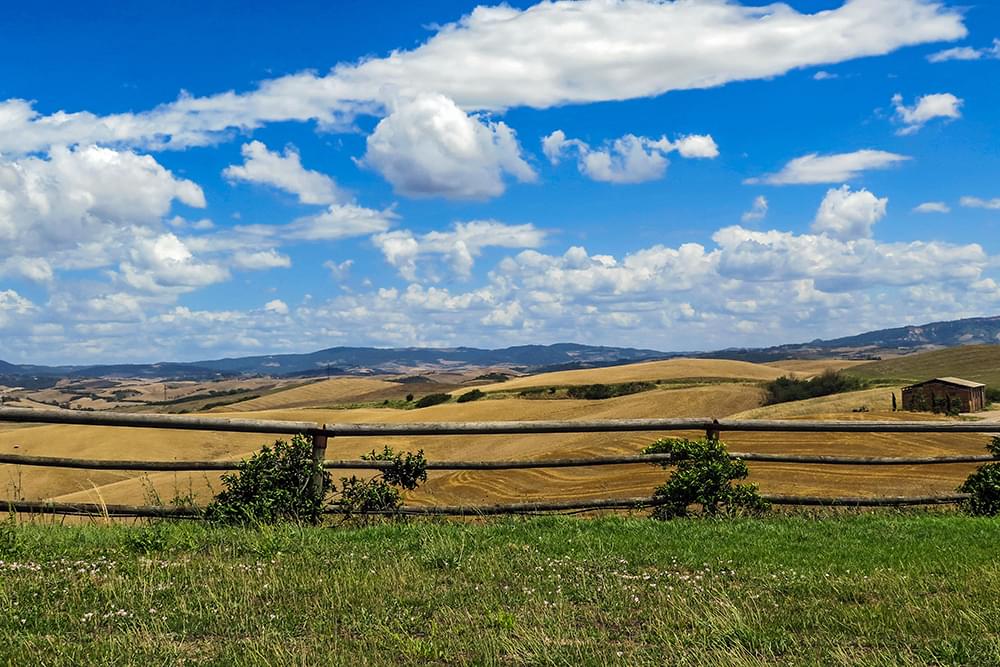
The province of Pisa, located in western Tuscany, is often overshadowed by its famous Leaning Tower. Yet beyond the city lies a diverse and fascinating territory filled with natural beauty, deep-rooted history, and charming small towns. The province stretches from the Tyrrhenian coast to the rolling hills that mark the heart of the Tuscan countryside.
Whether exploring ancient Etruscan sites, sampling wines in rural villages, or walking through pine forests beside the sea, the province of Pisa offers a quieter, richer side of Tuscany. Its landscapes, shaped by centuries of human presence, invite discovery and reward those who venture off the beaten path.

Inland from Pisa, the Valdera area offers a picture-perfect vision of Tuscany, with gentle hills, vineyards, and rows of cypress trees lining narrow country roads. This is where the province's agricultural roots run deep, and small towns like Terricciola, Lari, and Peccioli provide a peaceful escape among olive groves and rustic farmhouses.
Wine production thrives here, and the region is known for its Chianti wines, white Trebbiano, and artisanal foods. The landscape invites walkers and cyclists to explore the countryside, visiting family-run wineries and trattorias that preserve old traditions and offer warm, local hospitality.
The province of Pisa is rich in medieval architecture and artistic heritage. Villages such as Vicopisano and San Miniato showcase perfectly preserved old towns, with stone towers, fortified walls, and churches filled with Renaissance art. Many of these towns hold weekly markets and seasonal festivals that celebrate their history.
San Miniato is also famous for its prized white truffles, found in the surrounding hills and celebrated in a large autumn fair. The town’s elegant palaces and panoramic views make it one of the cultural highlights of the province, combining gastronomy, history, and stunning scenery in one destination.
The province is home to several protected natural areas that reflect its environmental richness. The Monte Pisano range forms a natural border with Lucca and offers forest trails, ancient monasteries, and sweeping views toward the sea. Hikers can enjoy peaceful paths with little foot traffic, even in peak season.
Another natural treasure is the Alta Valdera Reserve, known for its wildflowers, wooded valleys, and biodiversity. These areas are perfect for those seeking a deeper connection with nature, far from the crowds, and they reveal another side of Pisa province—untouched, quiet, and endlessly beautiful.
The history of the province of Pisa goes back long before the medieval era. This land was once part of ancient Etruria, and traces of Etruscan civilization can still be found throughout the region. The town of Volterra, while officially part of the neighboring province, was historically linked to Pisa and still influences the area culturally.
Closer within the province, the area around Casciana Terme and Lari holds hidden tombs, ancient roads, and small museums dedicated to Etruscan art and artifacts. Exploring these sites offers a fascinating glimpse into a civilization that helped shape Tuscany’s identity long before the Romans arrived.
The geothermal activity in the region has long been harnessed for health and relaxation. The thermal town of Casciana Terme is one of the most charming spa towns in the province, known for its healing waters and elegant 19th-century spa complex. Visitors come here for wellness treatments, spa experiences, and a tranquil atmosphere.
Surrounded by hills and vineyards, Casciana also offers great food and peaceful walks. It is a great place to unwind after days of exploring, and it embodies the slower pace of life that characterizes so much of the province of Pisa. Wellness here is not just about the spa—it is about being immersed in a gentler rhythm of life.
The coastal stretch of the province includes the resort area of Marina di Pisa and the wild beaches near the mouth of the Arno River. This part of the coast is less developed than other Tuscan seaside areas and offers both relaxation and nature. Pine forests stretch to the dunes, and birdlife is abundant in nearby wetlands and riverbanks.
Further south, the village of Calambrone has grown into a beach destination with family-friendly amenities, while the nearby Migliarino San Rossore Massaciuccoli Park offers a unique coastal ecosystem. The province’s coast is ideal for those who prefer quieter beaches and natural surroundings to large resorts and crowds.
The cuisine of the province of Pisa reflects its geography, blending coastal and inland influences. Seafood dishes like baccalà alla pisana and cacciucco are popular near the coast, while inland towns favor hearty stews, game meats, and hand-rolled pasta. Truffles, pecorino cheese, and chestnut flour products are regional highlights.
The wines of the province, especially those from the Valdera area, are gaining recognition for their quality and character. Many vineyards welcome guests for tastings, offering a personal glimpse into the life of Tuscan winemakers. Food and drink here are not just sustenance—they are expressions of culture and community.
Throughout the year, the province of Pisa comes alive with events that reflect its heritage. From medieval festivals in Lari to wine and olive oil fairs in Peccioli and Casciana, every season offers something special. These events are a great way to meet locals, taste traditional foods, and experience Tuscan culture firsthand.
Autumn is particularly vibrant, with harvest celebrations and truffle festivals drawing visitors from across Italy. Music, processions, food stands, and historic reenactments create a festive atmosphere that reveals the province’s deep community spirit and love of tradition.
The province of Pisa is a region of quiet beauty and surprising depth. While the Leaning Tower remains a global icon, the wider territory offers an authentic and varied Tuscan experience. It is a land of medieval towns, rolling vineyards, natural parks, and coastal escapes, all within easy reach yet far from the crowds.
Whether you are drawn by history, nature, food, or relaxation, the province welcomes you with open arms and gentle rhythms. It is a place where past and present coexist gracefully, and where every road, trail, and village has its own story to tell.

More Details



